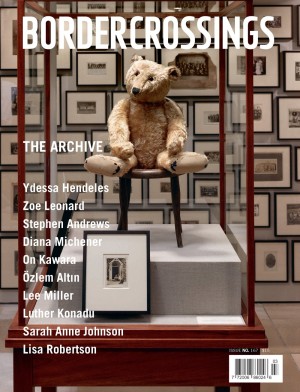“Evidence of Memory”
Ted Howorth’s last body of prints, seen at the Martha Street Studio in 2004, featured large black and white linocuts of giant, buoyant tortoises, floating and foreshortened, made mythic by Howorth’s imagination and technical skill. Something wondrous, those dark spaces of mass and bloat, shell and soft body, and something incongruous.
Howorth, teacher and artist, is a printmaker’s printmaker, and unusually, in a context where ethics rarely count, a mensch. We have exchanged classes: copper and chemicals for my Inuit Art students, an article by Adorno for his unlucky bunch. He has been involved in most printmaking ventures in Winnipeg—the Grand Western Canadian Screen Shop, the School of Art and the Manitoba Printmaker’s Association. A stalwart of the now defunct Site Gallery, he returns often for research stays at Toronto’s Open Studio. It was there that Howorth met Toronto-based artist Diane Birkenheier, and plans for the recent two-person show at Site Gallery—“Evidence of Memory”—ensued.
There is ample work here, enough for two solo shows. Birkenheier’s practice is based on the manipulation of photographs layered and translated onto acetate in mad combinations. Light boxes, composite wall hangings and singular icons share common images, inspirations and memories from sojourns in Rome and the small southern island of Procida, close to Naples. At first glance the work, in its horseshoe arrangement across three walls, is reminiscent of the over-saturated colour bleeds of cheaply produced Italian guidebooks, where pages fall haplessly and colour registration is only a wish. Fountains, villas, sexy men on motorcycles, hermaphrodites, columns, ruins, skies, folk and tourists abound. Is that Gina Lollobrigida? Hard to say behind the sunglasses. Birkenheier prints onto acetate, building subtle and screaming layers by photocopying and repeatedly redoubling the image.
On the long wall, these machine-age postcards in arrangements of one, two, three, six and so on are set off the wall with rods, so that the cast shadows create a sense of aura and depth. Her most endearing works are those filled with overt humour. Six interactive light boxes hung on the back wall have comedic and carnivalesque effects. Each box contains varieties of acetate images and a wind-up mechanism made for a music box. I sing along with “Volare.” It’s Fellini on an intimate scale.

E.J. Howorth, Horizontal Passage, 2005, digital inkjet print, 14 ½ x 40”. Courtesy the artist.
On two adjacent walls, a linear run of landscape-format prints from the past two years by Howorth blend digital and silkscreen techniques augmented by hand work in water-based crayon. The clarity and legibility of the motif, whether it is a pool, a hand, a swimmer, an SUV, a chain-link fence, or an exotic flower, suggest the arc and fall of a narrative unfolding. Swimmers navigate depths. Pools glisten in the early morning light. The view is often staged by the device of a repeated black vertical line, suggesting a filmic frame, or by a loose division of the print into triads where dissimilar patterns hold varying depths, textures and ideas. The saturated and intense reds, oranges and turquoises resonate with the Birkenheier installation.
Formal orthodoxies of framing and installation yield to the discovery that this horizontal grouping is less a single story with a consistent dramatis personae than an index of Howorth’s deep love and fascination with illusion and shifting characterizations. Swimmers— human, reptilian or in combinations— navigate both ice and water. While Birkenheier’s technique reinforces the resolute flatness, facticity and hovering nature of the image, easily transposed and dispersed by light, Howorth is always convincing in his suggestive re-presentations of deep space and the perceptually visible. He sounds depth upon depth with adaptations of digital media and technical regressions. He is fascinated by permutations and transformations, moving seamlessly from silkscreen to digital outputs. Yet, surprisingly, the motif upstages all this technical mucking about.
Where so many other printmakers of his generation toyed and played with the seductions of pretty abstractions, Howorth has rarely abandoned the image. These remain cinematic, three-dimensional, mathematic and poetic. If Winnipeg were Hollywood, no doubt Howorth’s engagement with surface, space and characterization would be writ large across the screen.
Perhaps the recourse to warmer climates and exotic locales, the use of intense colour, link the two artists in this exhibition. Some of Howorth’s references come from brief trips to Nevis, the Caribbean, or cottage country. Birkenheier is faithful to her Italian muse. I am not fond of the exhibition’s title, “Evidence of Memory”; it seems beside the point, a clumsy oaf of a lyric where subtlety and nuance reign. If I could retitle this show, I would. It would be an impractical title, too long to fit on an invitation. It would say something about dawn times and moonlit times, of a sun too bright, a swimmer in ice, or taut, gleaming pools. Weightlessness beckons. And in spite of the tradition of Site’s back room for solo, duo and group shows mounted by artists with wonderful showcases over the past ten years, I might possibly even recurate it, tinkering here and there. I’d add those grand tortoises, delete some icons, make the work larger. That’s the problem with fantasy narratives—they give rise to so many grand illusions. I have swum through ice, though. Truly, I have! ■
“Edvidence of Memory,” featuring the works of Diana Birkenheier and E.J. Howorth, exhibited at Site Gallery in Winnipeg from November 6 to 30, 2005.
Amy Karlinsky teaches art in the inner city.

